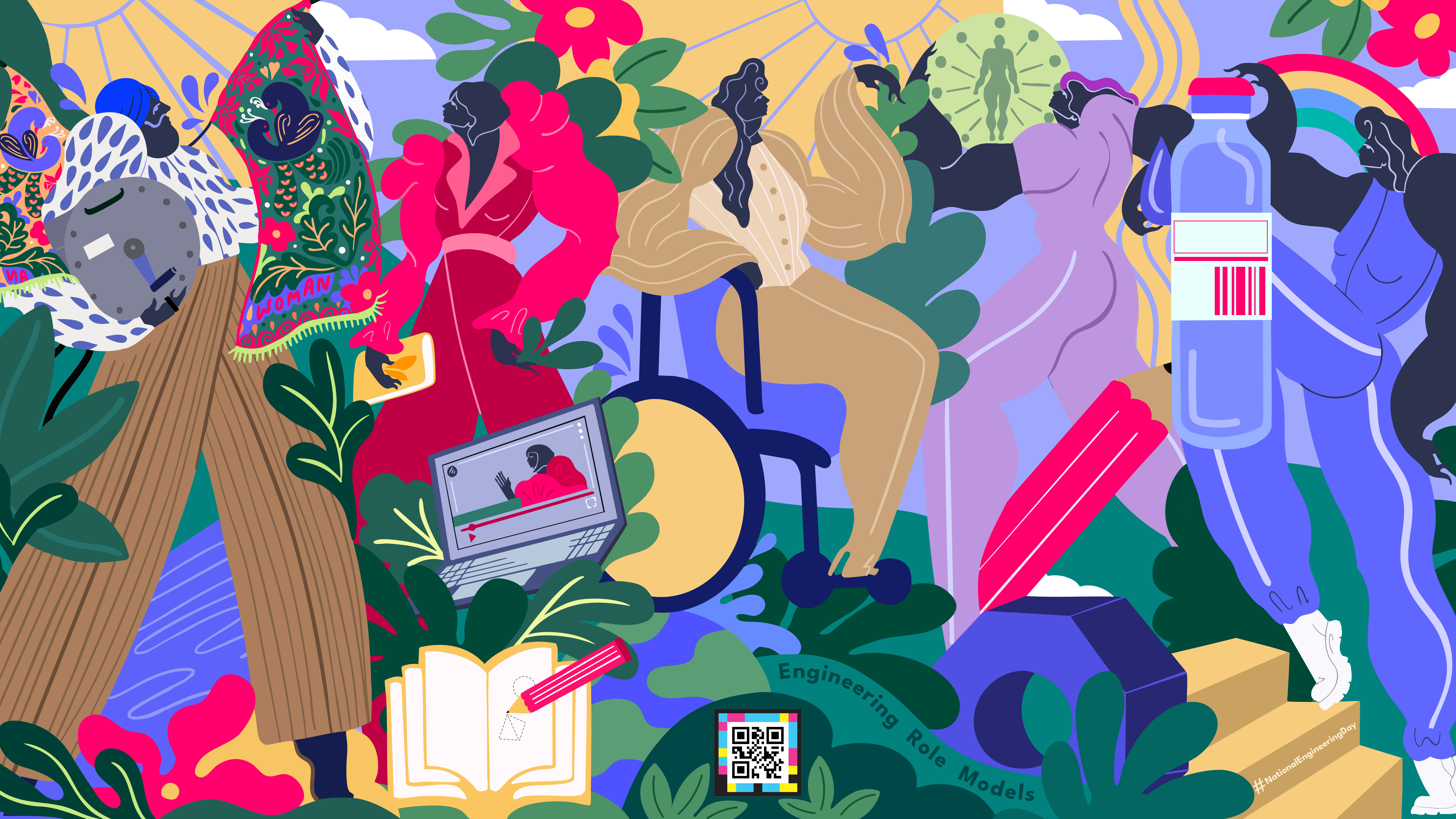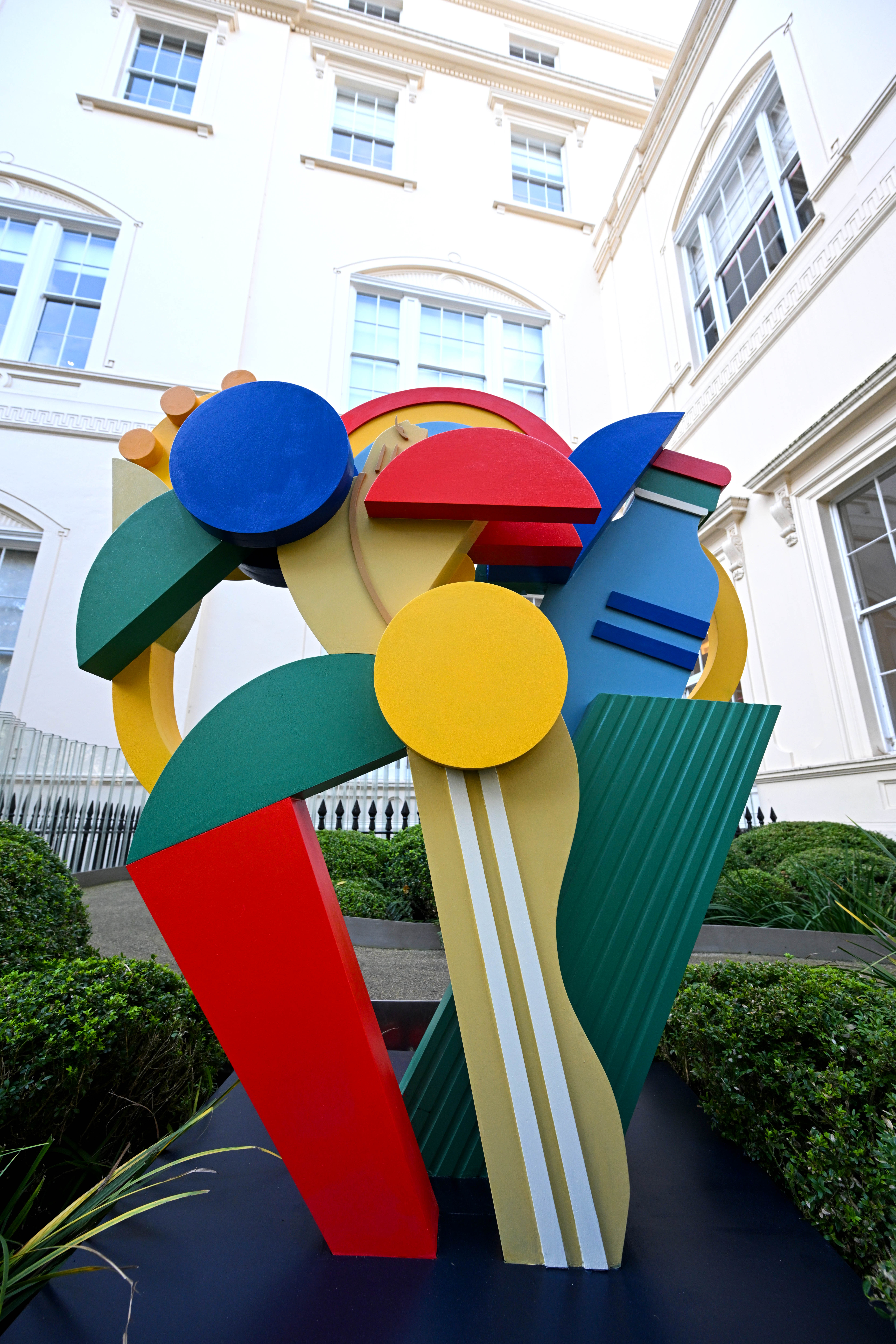
- The Royal Academy of Engineering, in collaboration with visual artist Kelly Anna, unveils a first: a modern statue of a living engineer to inspire a new generation into the profession
- According to PSSA UK (Public Statues and Sculpture Association) only about 3% of statues in the UK are of non-royal women, and none celebrate modern engineers
- The new statue unveiled on 13 November 2024 - National Engineering Day - aims to recognise an inspiring contemporary engineer – Alice Kan
Unveiled in central London, a striking new statue of a Macclesfield-based woman engineer. Not encased in traditional bronze or marble but in a modern and vibrant style, the statue of manufacturing engineer Alice Kan has been specially designed by visual artist and designer Kelly Anna to mark National Engineering Day 2024.
This year, the Royal Academy of Engineering aims to inspire a new generation to see themselves reflected in engineering by honouring Kan as a contemporary engineer who played a pivotal role in the manufacture of the COVID-19 vaccine and is now working on vaccines for Ebola.
The initiative comes at a pivotal moment for the engineering profession. With women still making up only 15.7% of the UK engineering workforce— down from 16.5% in 2023—the lack of visible role models is seen as a key factor in why fewer women are considering a career in engineering.
New research commissioned for National Engineering Day shows the crucial role of representation in inspiring the next generation, with 80% of respondents aged 12-15 naming the importance of having a role model to look up to for personal and career goals. However, almost half (44.%) struggled to remember an engineer featured in popular culture and more than half could not name a famous engineer.
With statues being named among the top three reasons to stop and take notice over other public displays, engineers – especially women – are almost absent from public monuments. While historical figures like Mary Seacole and Millicent Fawcett have been celebrated with statues in recent years, historical engineers like Beatrice Shilling (known for her ground-breaking work to improve Spitfire performance) and Dame Caroline Haslett (pioneer of household electrification, as a way to ease household labour) still lack this public recognition.
Dr Hayaatun Sillem CBE, CEO of the Royal Academy of Engineering, said:
"Engineering is driven by countless unsung heroes and teams who shape our world in profound ways every day. Across the UK, modern engineers—despite their remarkable contributions to our society—remain noticeably absent from public statues and monuments. Their achievements deserve to be celebrated more publicly, which is why, on National Engineering Day, we are using digital art and sculpture to bring their work—and their stories— to the wider public, and especially to those considering their future careers. We hope this will encourage more people from all backgrounds to join this creative, rewarding profession which improves lives every day."
The collaboration with the artist Kelly Anna is particularly meaningful, as her distinctive style celebrates positivity, confidence and leadership—ideals that resonate with 54% of young adults when choosing role models.
Kelly Anna has also designed a new digital artwork entitled Engineering Role Models. Alongside Alice Kan, it features four other inspiring engineers—Navjot Sawhney, Meg Ginsberg, Dr Shini Somara, and Laura Hoang—who each bring unique contributions and diverse backgrounds to their fields. All five featured role models were nominated by the public – over 150 nominations were received in total.
Artist Kelly Anna’s collaboration blends art and engineering to shine a light on five engineers whose achievements and career paths tell an inspirational story that’s relatable and accessible to young people seeking creativity and purpose in their careers.
“I’m thrilled to work with the Royal Academy of Engineering on this initiative,” said Kelly Anna. “These engineers are making a tangible impact on the world, and it’s exciting to translate their achievements into art that can inspire others. I hope that through these pieces, people will see how creative and fulfilling engineering can be.”
Alice Kan said about her statue: “Being honoured in statue form is a very unique experience and not something many people can say. I really hope my statue encourages people to understand more about engineering, what engineers do and why it is a great career for anyone who's got a curiosity for wanting to make things work better.”
Justine Simons OBE, London’s Deputy Mayor for Culture and the Creative Industries, said: “I’m delighted that the Royal Academy of Engineering's new statue honours bioengineer Alice Kan. It is important to highlight the invaluable contributions of women as we continue to help make a better London for everyone.”
The government’s mission to drive economic growth and make Britain a clean energy superpower will rely heavily on the skills of engineers and technicians. Yet, engineering is often seen as a hidden profession, with fewer opportunities for public visibility compared to careers like medicine or law. This year’s National Engineering Day is a bold step toward changing that perception and encouraging more young people from diverse backgrounds to pursue a career in engineering.
The public (and especially school-aged children) are invited to engage with the inspiring stories of this year’s featured engineers by visiting the Academy’s offices in Central London, where Kelly Anna’s sculpture of Alice Kan will be on display from 13 until 20 November, as well as exploring the Engineering Role Models digital artwork that will be on display across the UK on 13 November.

National Engineering Day statue - copyright Kelly Anna

Use your phone to scan the QR code and bring the statue to life through augmented reality
These displays showcase the incredible diversity and creativity of modern engineering, and are intended to spark curiosity and excitement in those considering their future career paths.
For more information on National Engineering Day and to explore the work of the featured engineers, visit This Is Engineering.
Notes for editors
KELLY ANNA’S STATUE
The statue of Alice Kan, crafted by Kelly Anna, encapsulates Alice’s remarkable journey, achievements, and personal resilience in engineering and vaccine production. The central, dynamic figure of Alice stands strong with an empowered posture, symbolizing her resilience, leadership, and unwavering determination. Alice is shown looking upward, representing hope, optimism, and her visionary approach to the future.
The statue is constructed from various blocks and shapes, representing her ability to build teams and overcome obstacles. These blocks embody persistence and inclusiveness—demonstrating how diverse perspectives come together to create strength. An accompanying QR code will take visitors to an augmented reality experience created by Atlantic Productions. Here, it will be possible to interact with the statue and learn more about the meaning of each element.
One of the key elements is a pencil, symbolizing Alice’s tenacity and her relentless pursuit of success. Known for her determination, Alice has often been described as tenacious, and the pencil signifies her approach to problem-solving and her preference for putting pen or pencil to paper to communicate ideas, particularly to non-engineers. This reflects her ability to break down complex concepts with clarity and collaboration, underscoring her role as a leader who makes engineering accessible to all.
The other acknowledges a significant personal and professional achievement: Alice is represented holding an oversized vial, symbolizing her significant role in the mass production of vaccines, such as those for COVID-19 and Ebola, and her contribution to public health. The abstract COVID-19 graphic on the base of the statue depicts three vaccine vials. Vials are a key symbol of Alices work on the vaccine as they both gave hope but also added complexity to the project. Alice has three of them on her desk as a constant reminder. Why three? Because it’s a three-step process to cap the vials.
A rainbow arches over her head, symbolizing diversity, inclusion, and renewal, while an abstract COVID-19 graphic on the base highlights her pivotal role during the pandemic. The vivid colours—yellow for curiosity, red for resilience, blue for perseverance, and turquoise for creativity—capture the essence of Alice’s character. The use of wood reflects sustainability and growth, mirroring Alice’s role as a role model for young women in engineering, inspiring them to reach for the sky.
This statue not only honours Alice’s technical contributions but also celebrates her tenacity, resilience, and commitment to making the world a more inclusive and better place for future generations.
FREE VISIT FROM 13-20 NOVEMBER
Royal Engineering of Engineering
Prince Philip House
3 Carlton House Terrace
London
SW1Y 5DG
ROLE MODEL BIOS
The statue:
Alice Kan, a mechanical engineer from Macclesfield, has made a significant impact on the world of vaccine production. Originally drawn to maths, she discovered her passion for engineering after attending a taster course at Cardiff University and she went on to study at UMIST/University of Manchester and later with the Open University. Alice began her career at AstraZeneca, working in various project and leadership roles for 13 years. When the pandemic hit, she became programme manager for the fill-finish of the Oxford-AZ COVID-19 vaccine at Wockhardt, where she led the team responsible for setting up the manufacturing AstraZeneca vaccines for the UK, making crucial technical decisions under immense pressure. Alice is now contributing to Sabin Vaccine Institute’s efforts to tackle two of the world’s deadliest diseases, Ebola and Marburg, by supporting the manufacturing of vaccines currently in Phase 2 clinical trials, inspired by her late sister Polly, a doctor who helped with the Ebola outbreak in Sierra Leone. Her work feels deeply personal, and she hopes to contribute to saving lives through her efforts. Alice is also passionate about addressing sexism in engineering and driving culture change to retain more women in the profession. She’s applied for a Churchill Fellowship to learn how other countries successfully support women engineers. Having overcome her own imposter syndrome during the COVID-19 vaccine project, she’s determined to continue tackling challenges in manufacturing and beyond.
The Digital Artwork from left to right:
Navjot Sawhney, or Nav, is a London-born aerospace engineer and is the founder of The Washing Machine Project. Having grown disillusioned with "making vacuum cleaners for rich people," Nav pivoted to humanitarian efforts in India, volunteering with Engineers Without Borders. There, he developed low-smoke cooking stoves and met Divya, a neighbour whose daily struggles with handwashing inspired Nav to design a washing machine that doesn’t use electricity or a fixed water source. This idea sparked The Washing Machine Project, a UK-based social enterprise dedicated to alleviating the burden of handwashing clothes, particularly for women in remote, low-income, and displaced communities. The Divya Washing Machine, named after this neighbour, is the world’s first flat-pack, manual washing machine. This innovative device saves up to 50% of water and 75% of time compared to hand washing, addressing a critical need for predominantly women and girls around the world who experience this burden every day. Now active in 15 countries, Nav's project aims to impact 150,000 people over the coming years. Nav believes that as an engineer you have a choice to help or hinder the planet. With partners like Whirlpool Foundation, he plans to scale the initiative, tackling broader global challenges in clean energy, mobility, and more.
London born Dr Shini Somara is a mechanical engineer and science communicator who is passionate about making engineering accessible to all. As a creative child, she loved building and making things but initially struggled with maths. After many years of focussed hard work, she later mastered maths to follow in her father’s engineering footsteps. At university, she discovered the combination of creativity and logic and developed a novel "freeze flow" technique in computational fluid dynamics, which is now used in hypersonic spacecraft modelling. Shini transitioned from industry to communications, hosting TV programmes such as Al Jazeera’s ‘Technow’ and creating educational content like "Crash Course Physics" videos, which have reached 50 million viewers. She’s also an author, with her first seven books aimed at inspiring children to pursue engineering. Committed to diversity and inclusion, Shini advocates for wider participation in the field, promoting apprenticeships and speaking in schools to inspire the next generation of engineers. Her mission is to bring engineering into the mainstream and help close the skills gap with a diverse and inclusive workforce.
Meg Ginsberg is an assistant project manager at South West Water who has forged an inspiring career in the wastewater industry after facing significant personal and professional challenges. Born in Guildford and now based in Devon, Meg became a mother during the pandemic and navigated multiple surgeries that left her a wheelchair user by the age of 18. Originally pursuing a career in nursing, she shifted to project management, completing an apprenticeship and soon to start a degree apprenticeship at Exeter. At South West Water, she manages large-scale projects across Devon and Cornwall, including flood and pollution reduction, working closely with engineers to modernise Victorian sewage systems and future-proof infrastructure. Passionate about inclusivity, Meg launched "Construct Ability”, an initiative to help disabled people enter and thrive in construction and engineering. With sights set on becoming an engineer herself one day, her unique perspective as a wheelchair user drives her mission to make the industry more accessible, adaptable, and diverse. Meg is proud to be part of an essential industry and hopes to continue changing perceptions and driving meaningful change.
Laura Hoang, a Leeds-born human factors engineer, defied family expectations to pursue her passion for engineering. An after-school project with National Grid sparked her interest, leading her to study systems engineering at Loughborough University. She spent 12 years at working in the aerospace industry, where she designed cockpits and training systems. After a shift into an environmental and sustainability consultancy, working with a broad range of industries including mining, wastewater and hydrogen projects, Laura joined Amentum and is now the human factors lead for a large-scale nuclear energy project. Her focus is on cutting-edge design to reduce human error and drive the UK towards its net-zero ambitions. Laura is committed to inspiring young people, especially girls from ethnic minority backgrounds, to see engineering as a viable and exciting career.
Alice Kan – bio above.
About National Engineering Day
National Engineering Day was created by the Royal Academy of Engineering to shine a spotlight on the vital role engineers play in shaping our world. Working with engineering institutions and industry partners across the whole of the UK engineering profession, it aims to inspire the next generation of engineers by showcasing the creativity, problem-solving, and impact engineers have across industries.
It's a national call to recognise the engineers who are essential to building our future, while also promoting diversity and inclusion within the profession; so when solutions are created, from developing sustainable infrastructure to cope with climate change to creating AI and robotics for healthcare, a wider range of voices are built in from the start, and the end product will have a better chance of being more successful for everyone.
National Engineering Day complements Tomorrow’s Engineers Week 11-15 November 2024, which works with schools to engage young people aged 11 to 14, demonstrating how their interests and passions can lead to exciting and fulfilling careers in engineering.
About Kelly Anna
Kelly-Anna is an acclaimed London-based artist and designer, celebrated for her bold, silhouetted figures that emphasize themes of movement, sport, and wellness.
Her distinctive style has made waves not only in the creative world, through major collaborations including Nike, BMW, Penguin, and the NFL, but also pop culture, with cultural icons like Beyoncé and Justin Timberlake sporting her design, cementing her as a force in both art and fashion. Beyond her design work, Kelly-Anna has shared her expertise on global stages, speaking at 18 of the world’s largest art and design festivals.
About Atlantic Productions
Atlantic Productions, founded in 1992, is a multi-award winning independent factual production company and pioneer in immersive storytelling. Atlantic’s award-winning television, theatrical films and immersive experiences have been seen in over 150 countries. Atlantic is respected for its unparalleled access and lead the way in the new era of immersive storytelling.
About the Royal Academy of Engineering
The Royal Academy of Engineering is a charity that is harnessing the power of engineering to build a sustainable society and an inclusive economy that works for everyone. In collaboration with our Fellows and partners, we’re growing talent and developing skills for the future, driving innovation and building global partnerships, and influencing policy and engaging the public. Together we’re working to tackle the greatest challenges of our age.

